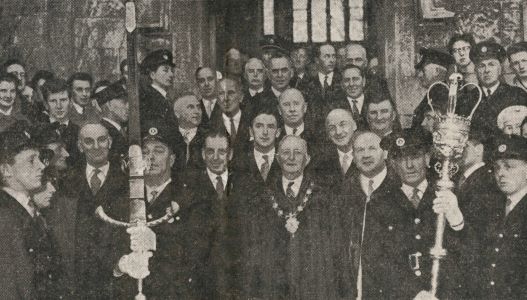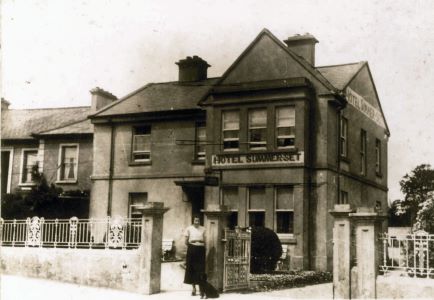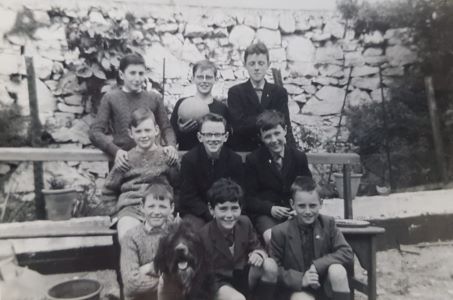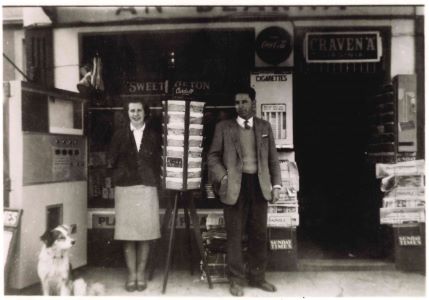Old Galway
DONALL MAC AMHLAIGH, GENTELMAN, WRITER, EXILE

by Tom Kenny
This photograph of some of the staff of the Rockville Hotel was taken in the summer of 1947. They were all well-dressed which would have been normal in hotels in Salthill at the time, porters would have worn swallow-tail coats and waitresses proper uniforms. The Rockville was originally a guest house owned by a Mr. Kelleher who was a member of the RIC. It evolved into a small comfortable hotel owned by O’Neills (“Private bathing from the Hotel, Phone Salthill 70”) and later by people named Hynes. As the Rockville it had high standards and was fully licensed.
THE GALWAY SWORD AND MACE

by Tom Kenny
The Galway civic sword and mace are among the finest specimens of municipal corporation insignia in Ireland: the sword is particularly noteworthy and can be compared with the best of civic swords in these islands. Swords and maces were first carried by the king’s servants as symbols of the authority of the king himself. As time went on, the mayors and bailiffs of towns acquired swords and maces of their own, some following charter grants, others by mere assumption without specific authority. These were usually borne before the dignitaries concerned when they went in procession or were actively displayed when they acted otherwise in their official capacity. Maces, which were originally weapons, are staves of authority. Swords symbolise the legitimate use of force.
The Summer-Set Hotel

by Tom Kenny
This building on Kingshill in Salthill was originally a guest house known as St Columba’s and was run by a Mrs Delaney. In 1933, Paddy and Bridie Hussey bought it and changed the name to The Summer-Set. They renovated and decorated it and advertised it as, “Beautifully Situated on the Sea Front, Home Comforts at Moderate Charges, Excellent Catering and Efficient Service under Personal Supervision, Touring Cars on the Premises for Hire, Free Lock-up Garage, Special Terms for Winter Months, Bus to Door.” The phone number was Salthill 36.
THE ART OF THE LETTER HEAD

by Tom Kenny
Our illustration today is of the letterhead of J.J. Ward who owned The Motor and Cycle House on Eyre Square. This building is shown on the left of our illustration. It was originally occupied by Gilbeys and was next door to what is the Imperial Hotel today. James Ward set up in business here in 1903 and invited the public to ‘inspect the largest stock, the best chosen variety and the best value in Connaught in Cycles and Accessories’. In 1909 he wrote “In my repair shop, I have the same group of hands working who have worked under me for 6 years – they know their work and do it well. I’ll give you a cycle for £7. 7s as good as you can get elsewhere for a much higher price. In fact it is worth £9. 9s.”.
BLAKE’S CASTLE, QUAY STREET

by Tom Kenny
This drawing of Blake’s Castle was done in 1847 by George Victor Du Noyer, a Dublin born artist, geologist, and antiquarian who spent much of his life recording natural features and archeological sites around the country in the 19th century.
Blake’s Castle is a medieval town house built c.1470 having single bay ground and first floors and a 2-bay second floor. It has a flat roof with a crenelated parapet with a projecting machicolation on supporting corbels on the top floor above the entrance. This was an opening at the parapet through which defenders could drop stuff like boiling water down on would-be attackers. It was built with coursed roughly dressed limestone rubble walls with square-headed window openings to the upper floors.
THE FORSTER STREET TIMES, 1964-1966

by Tom Kenny
Those were the years that a very enthusiastic and talented group of children in the Forster Street area ran a local newspaper each summer under the banner ‘The Forster Street Times’. Their motto “Frank, Fearless and Free” was beneath the title. It was frank, it was fearless but it was not free, it cost a penny an issue for the first two years. Economic circumstances being what they were in the mid-sixties, they were forced (because of the heavy cost of printing and the increased wages for the staff) to put the price up to two pence per issue in their third year.
THE HOLLAND INFLUENCE IN GALWAY

by Tom Kenny
In the year 1900, Patrick Holland had a travelling shop near Athenry. He later opened a shop there and is credited with having the first car in the town. In 1914 he met Dorinda Egan and it was love at first sight. They married and had five children Brendan, Michael, Maureen, Angela and John. They eventually moved to Galway in 1930, and tried to set up a business in Dominick St. but the bank would not give them the money. They eventually managed to buy the premises of Mary Leahy’s Newsagency in Williamsgate Street.
AN BEARNA

by Tom Kenny
In 1928, Galway Urban Council prosecuted a Mr. James McHugh from Bohermore for failing to comply with a notice requiring him to remove his butcher’s stall at Kingshill, Salthill, on the grounds that he had built it without authority, beyond the alignment of the adjacent houses. In fact, Mr. McHugh had already sent the council a letter requesting permission to build the stall but the council were not yet aware of their powers at the time, and their solicitors had advised them that they, the Council, did not have any control over the erection of such structures. Though they did not approve of the stall, they had failed to notify Mr. McHugh. The case went in and out of court but the stall stayed where it was.
.png)